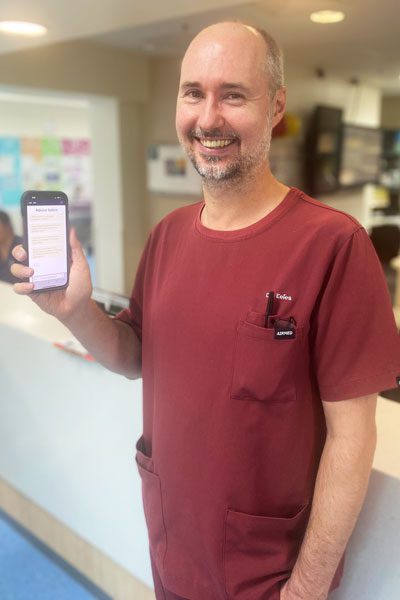World first electronic tool helping determine causes of delirium

Dr Eamonn Eeles has been working with researchers at the University of Queensland to develop a tool to help diagnose the causes of delirium
A world first algorithm is helping clinicians determine likely causes of delirium, one the most underdiagnosed conditions in a hospital setting.
Delirium is a common side effect of hospital admissions, mostly affecting older Australians. Costing Australia $8.8 billion each year, delirium is a complex condition that affects around one in five patients.
Geriatrician at The Prince Charles Hospital (TPCH), and University of Queensland PhD candidate, Dr Eamonn Eeles said that because of the many possible causes of delirium, it may be missed in around half of cases.
“Patients with delirium will experience profound disorientation and a disconnection with reality. Causes may be due to a variety of factors including infection, organ dysfunction, and drugs, to name just a few,” Dr Eeles said.
“One of the problems is that patients with delirium may not be able to articulate what is wrong. Examination might be a challenge because of drowsiness where a patient may be quiet or seemingly withdrawn. Alternatively, a patient may be agitated. In these situations, a diagnosis may be missed.
“Delays in diagnosis and treatment when managing delirium in patients is said to quadruple risk of mortality. That’s why timely diagnosis is crucial.”
To address this, Dr Eeles, in collaboration with TPCH Internal Medicine Service and The Dementia and Neuro Mental Health Research Unit at The University of Queensland Centre for Clinical Research, has created an electronic algorithm to quickly capture likely causes of delirium in patients.
Ten years in the making, the algorithm has progressed from pen and paper to an online tool recently successfully trialled by doctors and implemented at TPCH.
The new electronic tool uses conventional principles combined with intelligent design features such as adaptive testing to give clinicians a thorough yet user friendly tool to help diagnose this complex condition.
It employs a series of yes/no questions which helps narrow down causes to select groups such as infection, organ dysfunction, or drugs.
“The platform provides doctors with a tool to help quickly assess the patient’s symptoms to determine likely causes and develop an appropriate treatment plan,” Dr Eeles said.
“It is especially useful for junior doctors who sometimes have to manage the care of patients in the middle of the night without quick access to senior clinicians.”
The world first electronic tool has been successfully implemented in medical wards at TPCH, with positive feedback from junior doctors about its user-friendliness.
Plans are in place to collaborate with other hospital departments including emergency medicine to expand the scope and benefits of this revolutionary tool.
